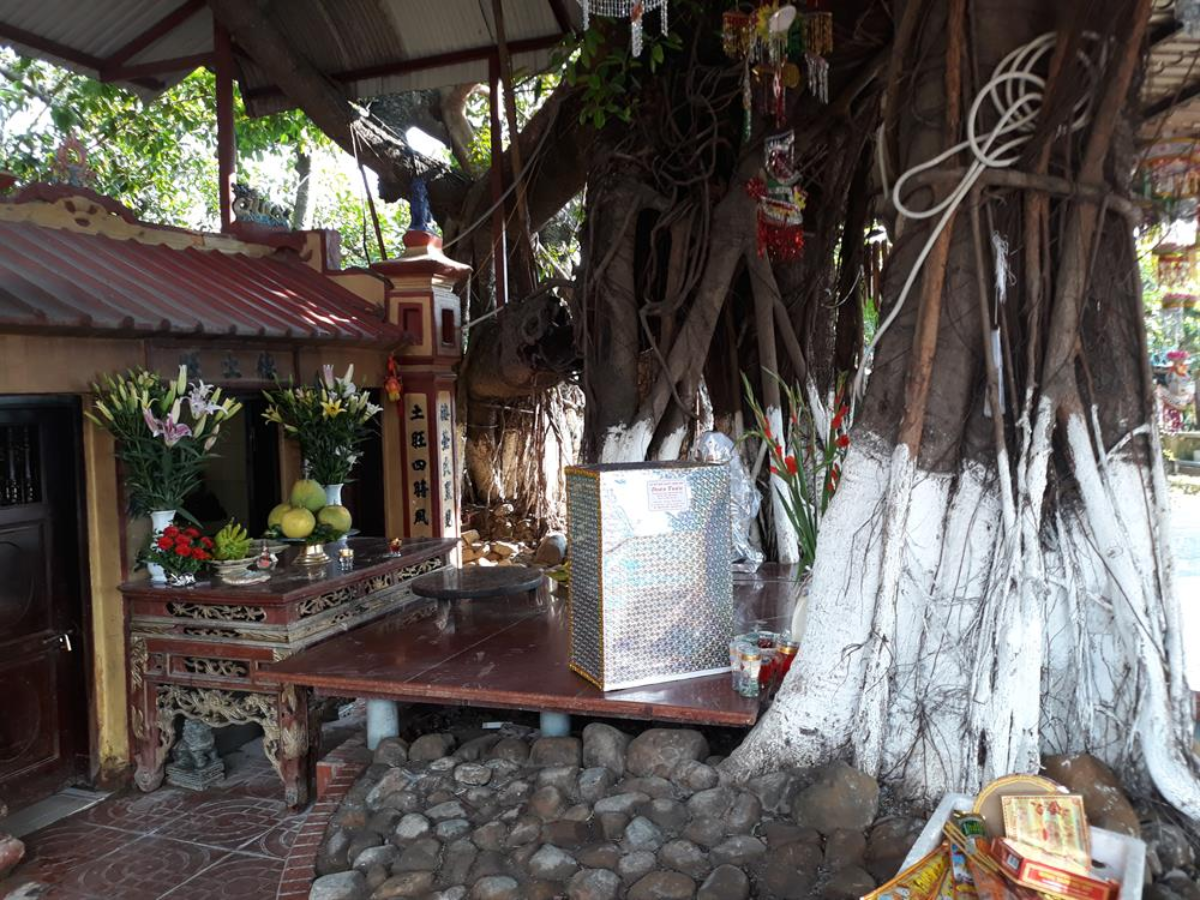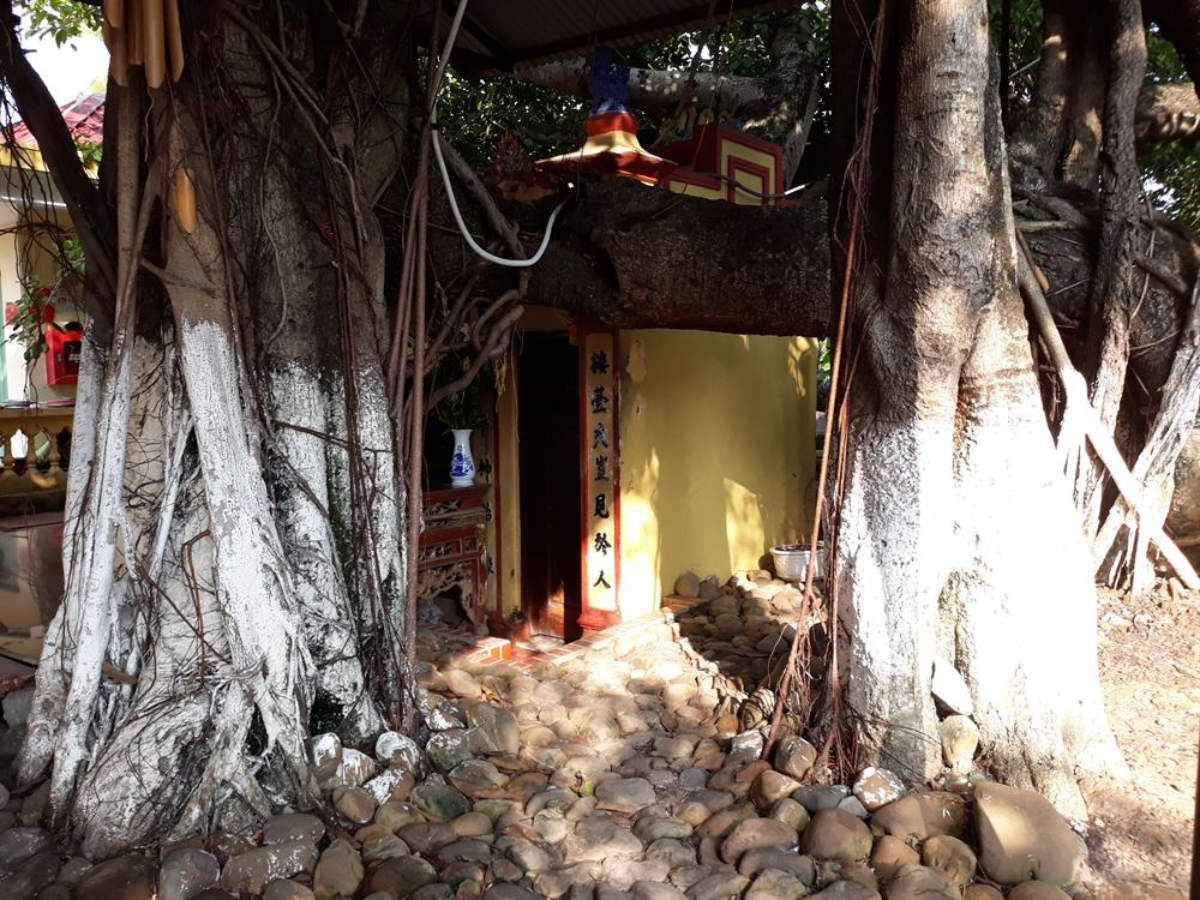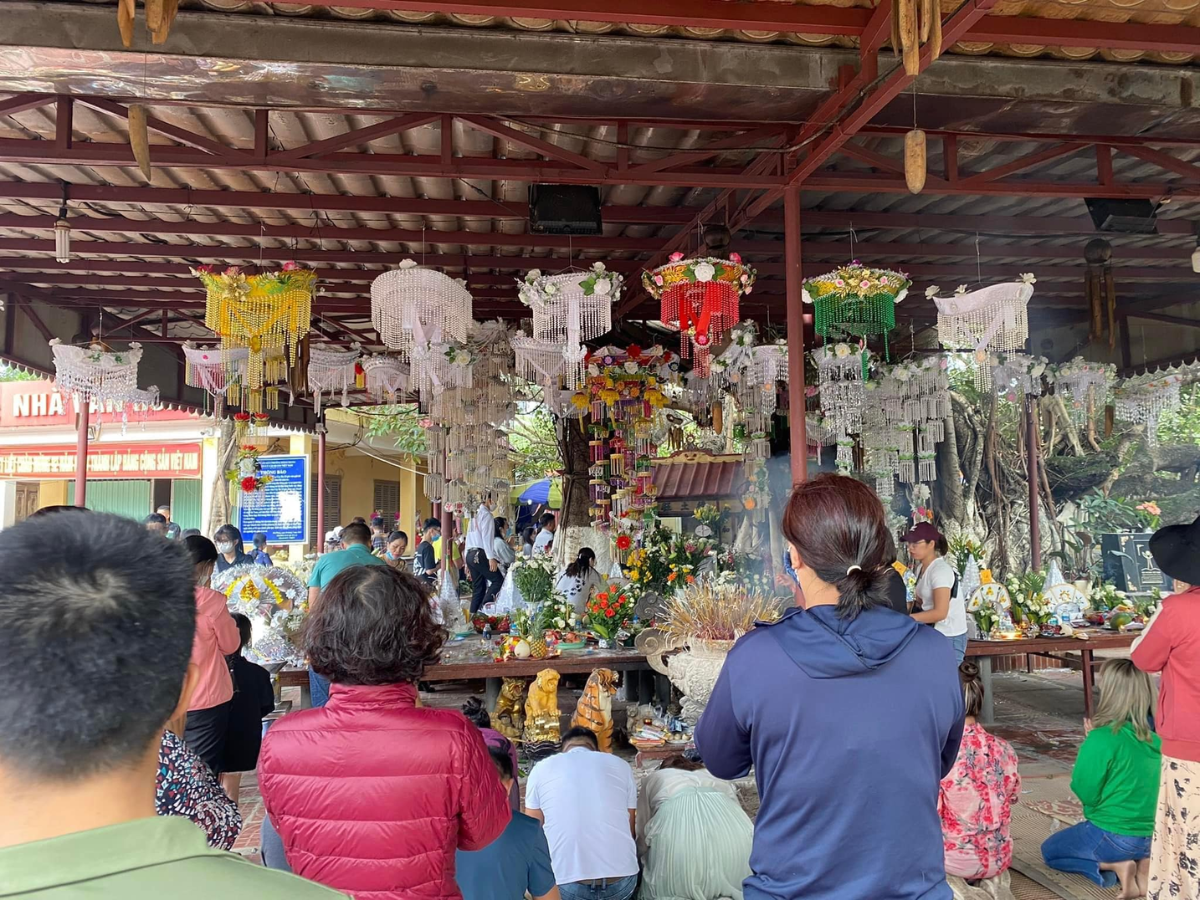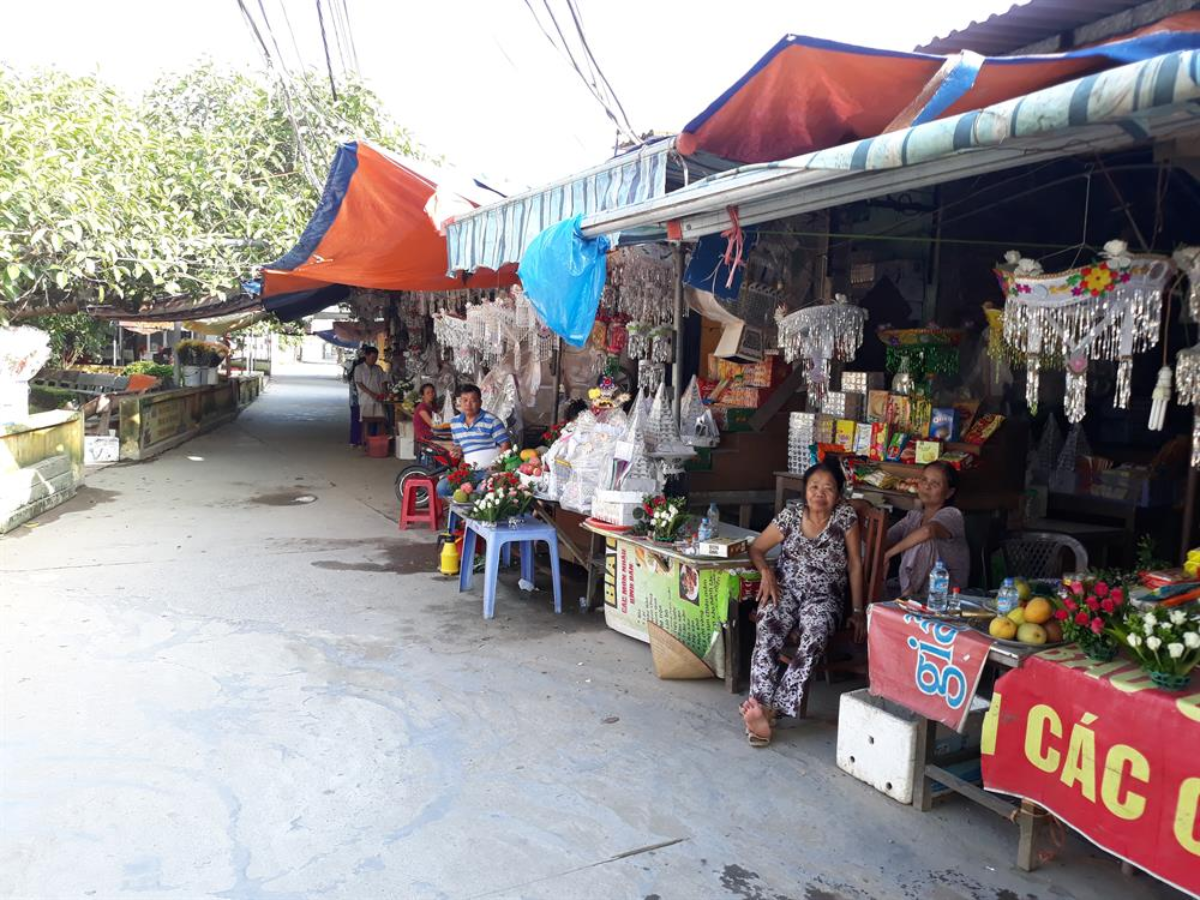1. Overview of the 13-root Banyan Tree Hai Phong
1.1. Geographical location and history of formation of the 13-root banyan tree
Located in Trai Hamlet, Gia Vien Ward, Hai Phong, adjacent to the ancient relics of the Port land, the 13-root banyan tree has witnessed many historical changes. According to documents, the banyan tree developed in a special natural environment when the main trunk broke its top, from which many secondary roots formed, creating a unique and rare tree shape.
The circumference of the entire root system reaches over 30 m, showing the enduring vitality of this banyan tree through centuries. Its convenient location, near bustling residential areas and transportation routes, allows pilgrims as well as tourists to easily visit and pay homage, experience the sacred space, and participate in spiritual activities here.

Close-up view of the 13-trunk banyan tree in Hai Phong. (Source: Collected)
1.2. Outstanding Cultural and Spiritual Values
This area is known as a land rich in cultural and spiritual traditions. The 13-trunk banyan tree has become the center connecting the spiritual life of the community, a place where many important worship activities and festivals take place. The large canopy acts as a protective cover for the religious structures below.
This spiritual space not only welcomes the people of Hai Phong but also attracts devotees and tourists from many places. The cultural values are outstanding through diverse beliefs, worshiping traditional deities while also making space for wandering souls, deeply reflecting the humanistic aspects of Vietnamese life.
1.3. Why Did the 13-Trunk Banyan Tree Become an Attractive Destination in 2026?
In 2026, Hai Phong's 13-trunk banyan tree was chosen by many tourists thanks to its unique combination of history, culture, and spirituality. The impressive beauty of the ancient tree, along with captivating legends, creates a unique appeal.
Especially, as the demand for spiritual tourism experiences increases, this place becomes a destination for those seeking peace and good fortune. Traditional festivals take place vibrantly with many unique cultural and artistic activities, bringing visitors unforgettable memories.
2. Who is Worshipped at Hai Phong's 13-Trunk Banyan Tree?
2.1. Duc Tho Vuong
Within the belief system under the canopy of the 13-trunk banyan tree, Duc Tho Vuong is the deity most revered by the people. He is considered the protector of the land, ensuring bountiful harvests and the people's peaceful lives. In the area around the banyan tree, steles recording the legend of Duc Tho Vuong demonstrate the long-standing tradition of worship and the villagers' deep gratitude.
According to preserved texts, Duc Tho Vuong was instrumental in reclaiming and establishing a stable life for the people of this region. The people often believe that thanks to his protection, the land of Hai Phong develops increasingly and life becomes prosperous. The ceremony to worship Duc Tho Vuong is often held on the first days of the month and on the full moon, with pure offerings and solemn rituals.

The temple worships Duc Tho Vuong right under the banyan tree. (Source: Collected)
2.2. Goddess of the Five Directions (Chua Nam Phuong)
The Goddess of the Five Directions is one of the important female deities in the Four Palaces belief, honored by the people of Hai Phong as the protector of life and business in the Port land. When researching who the 13-root banyan tree in Hai Phong worships, the name of the Goddess of the Five Directions always receives special reverence.
According to legend, the Goddess, along with two maids, traveled by rickshaw through many places in Hai Phong and stopped under the shade of the 13-root banyan tree to rest. Since then, this place has become a sacred worshiping palace, a location where worship rituals are frequently held on the full moon, the first day of the lunar month, and during Tet holidays. People come to the palace to pray for peace, happiness, and prosperous business with deep reverence.
2.3. Temple of the Goddess
The temple worshiping the Goddess under the shade of the 13-root banyan tree is a typical spiritual highlight, symbolizing abundance and protection from the deities. The construction of the temple is associated with the Mother Goddess worship and legends about spiritual energy gathering in this land.
The temple features the traditional Northern Vietnamese architectural style with gracefully curved roofs and exquisite carved patterns. Inside is a solemn worship space, with altars, offerings, and worship items carefully arranged. Legend has it that the efficacious Goddess frequently helps people in times of difficulty, creating a strong bond between the relic and the community's spiritual life.
2.4. Deities, spirits, young spirits, officials, and homeless souls
A special aspect when researching who the 13-root banyan tree in Hai Phong worships is that it also enshrines deities, young spirits, commanding officials, and especially homeless souls. This worship reflects the profound humanist philosophy of "the intact leaf shelters the torn one" of the Vietnamese people.
This diverse worship shows the tolerance and compassion of the local community. The banyan tree is not only a spiritual sanctuary for the living but also a place of solace for wandering souls. Ceremonies for the young spirits and souls are often held with the wish for their transcendence, while also conveying hopes for peace and protection for families and the community.

The temple was established under the banyan tree. (Source: Collected)
3. Folklore about the 13-trunk banyan tree in Hai Phong
3.1. Ancient tales and prominent legends
Among the treasury of legends related to the 13-trunk banyan tree, the story of the Trung Sisters is one of the most widely mentioned tales. According to the narrative, when the Trung Sisters rode elephants to battle against the Nam Han invaders, the army once stopped to rest by the ancient banyan tree. At that time, the elephant used its trunk to break off the treetop to eat, causing the tree not to grow tall but to spread wide, forming its current unique shape.
Another story tells of an ancient general who tied his horse to the banyan tree's trunk while on campaign. The horse was too strong and pulled off the treetop, and from that break, many smaller trunks grew, forming the 13-trunk cluster seen today. Additionally, there is a legend about an ill-fated female singer during the French colonial period, adding to the mystical and sacred aura of the relic site.

The temple is inscribed with prominent Han characters. (Source: Collected)
3.2. The Impact of Legends on Worship Beliefs
The legends mentioned above are not just folk tales but also contribute to nurturing spiritual beliefs at the 13-root banyan tree . They enhance reverence and create a widespread appeal, drawing local people and visitors from all directions to pray for blessings and peace.
The ancient stories help the communal courtyard and the banyan tree's canopy become a place where history and spirituality harmonize, symbolizing the local area's strong vitality under the protection of the deities. As a result, the community's faith becomes more sustainable, maintained and passed down through generations.
4. Rituals, Festivals, and Spiritual Experiences at the 13-Root Banyan Tree in 2026
4.1. Main Annual Rituals
When learning about who is worshipped at the Hai Phong 13-root banyan tree , visitors will have the opportunity to witness special spiritual rituals that take place year-round. The ceremonies to worship Duc Tho Vuong, the Five Directions Lord, along with the spirits of children and the homeless, are the main rituals, held periodically.
Locals typically prepare pure offerings such as incense, flowers, fruits, and traditional dishes to offer at the base of the banyan tree. The prayer rituals use traditional incantations, showing deep respect for the deities. Visitors attending the rituals should choose modest and neat attire to be appropriate for this sacred space.

Visitors perform the ritual of praying before the banyan tree shrine. (Source: Collection)
4.2. Unique Festivals, Traditional Holidays
The New Year festival at the 13-trunk banyan tree is held on the 14th day of the first lunar month, attracting a large number of people and tourists to offer incense for blessings and wish for a prosperous new year. Additionally, on the days of worshipping the Goddess, the full moon of the seventh lunar month, and during Tet, this place also becomes a gathering point for many community activities and meaningful worship rituals.

Spiritual goods serving visitors for pilgrimage. (Source: Collected)
In addition, traditional art performances such as folk rituals, lion dances, Hat Van (spiritual singing), and palanquin processions are also vibrantly organized under the banyan tree, helping to preserve and spread the heritage values of Hai Phong. Especially, in 2026, the festival here will also be connected with major city events, contributing to attracting more tourists and bringing rich, diverse experiences.
Besides visiting the Cay Da 13 Goc (13-Root Banyan Tree), a symbol associated with the history and life of the people of Hai Phong, tourists can also combine exploration with many other attractive destinations such as Do Son Tourist Area, Cat Co beach, or experience the Sun World Cat Ba cable car, which has the world's tallest towers, offering a journey to fully admire the magnificent beauty of Lan Ha Bay and the Cat Ba archipelago from above.
Cay Da 13 Goc Hai Phong is not only a witness to history but also a sacred symbol in the cultural and spiritual life of the people of Hai Phong. Under the shade of the ancient banyan tree, generations have entrusted their faith, gratitude, and aspirations for peace. Visit at least once to feel the solemn, sacred space here, preserve meaningful moments for yourself, and share that experience so that the heritage values continue to spread to more people.



